
The exhibition “The Greeks: From Agamemnon to Alexander the Great” in US
The exhibition “The Greeks: Agamemnon to Alexander the Great» will be presented at the Field Museum in Chicago. Specifically from November 25th 2015 until April 10th 2016, visitors will have the opportunity to see up close unique exhibits. Sculptures, masks, vases, jewelry, armaments and archeological treasures rarely permitted to leave their country of origin. More importantly, the show will use these objects to explore the evolution of ancient Greek politics, economics and culture, and provide a better understanding of the fertile soil out of which grew the democratic concepts, literature, theater, art, architecture and athletics considered foundational elements of Western civilization.
Developed in conjunction with the Hellenic Ministry of Culture, Education and Religious Affairs in Athens, two Canadian museums (the show already has been seen in Ottawa and Montreal), and the National Geographic Museum in Washington, D.C. (where it will head following its U.S. debut at The Field), “The Greeks” is being presented in Chicago in partnership with the handsome and intimate National Hellenic Museum located at 333 S. Halsted, in the heart of Chicago’s “Greek Town.”
Chicago has certainly been no stranger to Greek culture in recent seasons. This is, after all, the city that flocked to “All Our Tragic,” The Hypocrites’ award-winning production – a daylong marathon of all the existing Greek tragedies. And a vividly modern, 90-minute production of Aeschylus’ “Agamemnon” is now on stage at Court Theatre through Dec. 6. But the Field Museum show will take a more expansive look at the history.
“This is not just another art history show about the ancient Greeks,” said William Parkinson, an anthropologist and associate curator at the Field who is overseeing the show’s installation here.
“Its aim is to explore the way the people of that region perceived themselves and the world around them, and how this changed over many millennia. And the focus will be on telling this story through particular figures and individuals — some, like Agamemnon, who might be fictional in part, and some like Alexander the Great, who we know was very real. Along the way we look at the flowering of the city-states, and then Alexander’s takeover of most of the known world in what became the first imperial civilization. We also try to point out what was unique to this region, and what was taking place elsewhere, as well.”












